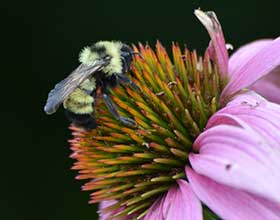 As pollinators of both crop species and wildflowers, bees are critical elements of Ohio’s economy and natural landscape. Our most familiar bees surely are honeybees, which were imported from Europe in the 1600s. However, Ohio also is home to more than 400 native species of bees. Among those, probably the most recognizable are the bumble bees. Bumble bees illustrate a number of points regarding Ohio’s bee diversity.
As pollinators of both crop species and wildflowers, bees are critical elements of Ohio’s economy and natural landscape. Our most familiar bees surely are honeybees, which were imported from Europe in the 1600s. However, Ohio also is home to more than 400 native species of bees. Among those, probably the most recognizable are the bumble bees. Bumble bees illustrate a number of points regarding Ohio’s bee diversity.
Although bumble bees might appear to be a single kind of bee, at least 9 species inhabit Greene and Montgomery Counties; several others have been seen (rarely) statewide in recent years. Common eastern bumble bees (Bombus impatiens) are the most common, followed by brown belted (Bombus griseocollis) and two-spotted bumble bees (Bombus bimaculatus). Each bumble bee species has diagnostic color patterns: common eastern bumble bees have a mostly black abdomen, while in golden northern bumble bees it’s almost completely yellow. However, there are variations even within a single species, and differences between others (e.g., black-and-gold vs. American bumble bees) can be rather subtle. So, distinguishing species sometimes takes close examination.
Bumble bees have distinct seasons of activity. Unlike honeybees, which accumulate food during summer and fall to sustain the colony through winter, only the mated queen bumble bee survives through the cold. All other bumble bees die off after their active season. In spring, bumble bee queens emerge, forage, and restart the colony. Two-spotted bumble bees are most active locally during March through August; for golden northern bumble bees, it’s April through September.
Bees pollinate something like 85% of wild plants. Some bees are generalist pollinators and visit a wide array of flowers, while others are specialists. Conversely, some flowers attract a wide variety of pollinating insects, while others depend on particular visitors. Bumble bees are generalists and can be found visiting flowers ranging from jewelweed to wild roses and from coneflowers to Virginia bluebells. Quite a few flowers, including mayapples, Dutchman’s breeches, pickerelweed, monkeyflower, and blue flag iris, rely primarily on bumble bees for pollination.
Bumble bees are cavity nesters; they live in colonies of several hundred bees (compared with many thousands in honeybees) in natural cavities, like rotting logs, that may be above ground or underground. Like honeybees, most bumble bee colonies have a distinct social system. A single female in each colony—the queen—establishes the nest and lays all of the eggs. Some of those eggs are fertilized and develop into female workers (a few of them grow to be new queens). Worker bees visit flowers to feed, and they return some nectar and pollen to the nest. Whereas honeybees accumulate enough honey to feed the hive for a full winter, bumble bees only make enough honey to carry them through a short spell of bad weather. Some time later in the active season, often not until summer, the queen also lays some unfertilized eggs. Those unfertilized eggs develop into male drones. Drones really have a single function: to find and fertilize virgin queens from other colonies that will go on to establish their own nests.
Bumble bees are the only truly social native bees in Ohio. Most other bees are solitary, though in the right conditions they may nests in aggregates that give the appearance of a colony. But even among bumble bees there are variations. The most extreme variation among our local bumble bees occurs in a species called the lemon cuckoo bumble bee, Bombus citrinus. Why “lemon cuckoo”? Well, the “lemon” part is easy: the thorax and about half of the abdomen is a pale, lemony yellow. As for the name “cuckoo”: that relates to the resemblance of the bee’s mating system to that of the famous European cuckoo bird. European cuckoos are nest parasites; they lay their eggs in the nests of other, usually smaller, species, and those other species then do all the work of raising the cuckoo chicks. Something similar occurs in lemon cuckoo bumble bees. In those bees, a mated lemon cuckoo queen sneaks into the nest of either a common eastern bumble bee colony or a half-black bumble bee (Bombus vagans) colony. There, she kills the resident queen, eggs, and larvae and lays her own eggs. She also acquires the chemical signals of the nest, which tricks the workers into taking care of her and her offspring. Pretty tricky!
Unfortunately, bumble bees also highlight another issue for Ohio’s bees—that is, the challenges to their numbers and diversity. In 2017 and 2018, a large state-wide survey found 10 species of bumble bees. One species (the rusty-patched bumble bee) previously widespread in Ohio was not found in that survey and appears to have disappeared from the state. Several other species now are rare. Challenges for populations of native bee species include land use practices (e.g., deep tilling that can disturb ground-nesting bees), diseases, and effects of pesticides, among others.
There are many ways to support the health of our native bees, including diversification of lawns and gardens to include more flowering plants, minimizing pesticide use, and fostering bee nesting sites (e.g., leaving soil undisturbed and providing log piles or rock walls). However, to rephrase a well-known saying, we are more likely to conserve what we know, and to know what we experience and attend to. Challenge yourself to identify and find a golden northern or a black-and gold bumble bee, or see how many bumble bee species you can identify around your own home. The better you know your bees, the more you will appreciate them!
Article and photo contributed by Dr. David L. Goldstein, Emeritus Professor, Department of Biological Sciences, Wright State University.
